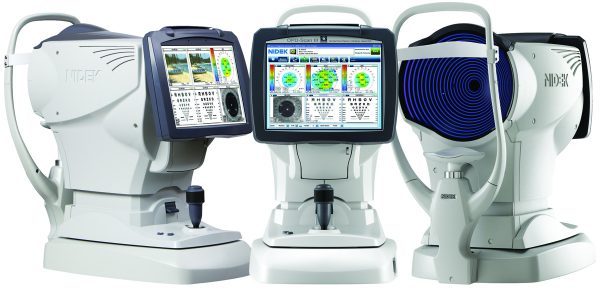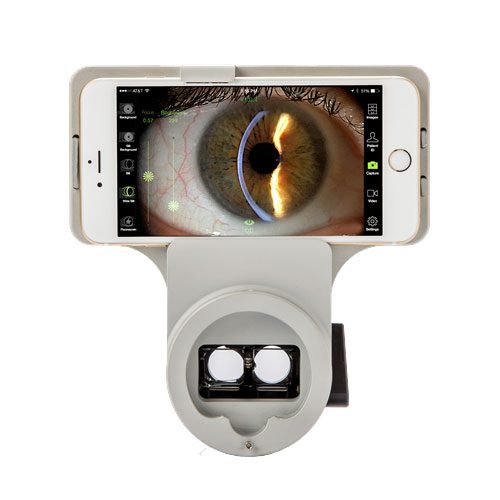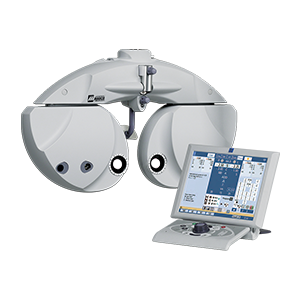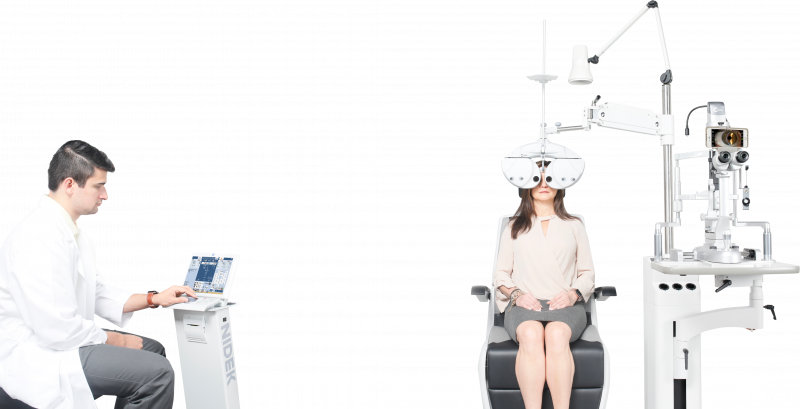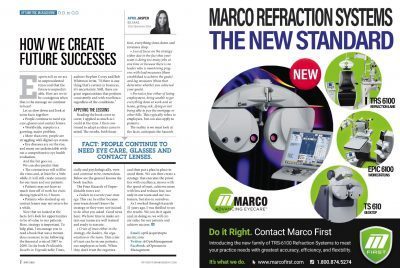Category: Marco Blog
Replicate A Model That Works – An Article From Women in Optometry
Original Article Published in Women in Optometry
–
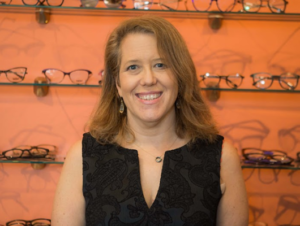 Dora Sudarsky, OD, had been considering the right time to equip a second exam room at her practice, Chroma Optics, in Burlington, Vermont. Her son will be graduating from optometry school in May 2021 and will join her in the office, so she knew the change was on the horizon. “I knew I needed to add another lane, and with COVID, I decided now was the time to do it,” Dr. Sudarsky says. She added a second TRS system from Marco as well as the ION slit lamp earlier this year, and working between two systems is allowing her to be more efficient seeing patients. She can alternate from room to room, which leaves more time for cleaning between each visitor. “It’s been awesome.”
Dora Sudarsky, OD, had been considering the right time to equip a second exam room at her practice, Chroma Optics, in Burlington, Vermont. Her son will be graduating from optometry school in May 2021 and will join her in the office, so she knew the change was on the horizon. “I knew I needed to add another lane, and with COVID, I decided now was the time to do it,” Dr. Sudarsky says. She added a second TRS system from Marco as well as the ION slit lamp earlier this year, and working between two systems is allowing her to be more efficient seeing patients. She can alternate from room to room, which leaves more time for cleaning between each visitor. “It’s been awesome.”
TECHNOLOGY IS A TOP PRIORITY
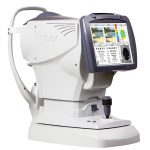
Dr. Sudarsky opened the practice in 2015, renovating and redesigning the space that was a former video store. She did most of the interior design and decorating herself to allot more of her funds to her instrumentation. Marco was on her wishlist from the start, and she opened her doors with one TRS system and the OPD III in her pretesting area. “The OPD III was above and beyond what anybody else had, and that was a big appeal,” she recalls.
Many patients followed Dr. Sudarsky from the optical where she had previously offered her optometry services, and in that space, she did not have any advanced technology. So the impression on patients has been huge and continues to be when new patients come to her office. “They tell me they’ve never seen so much technology, and while it may not all be brand-new, not every eye care practitioners embraces it the way that I have.” She recalls as she was preparing to open the practice that a colleague told her to wait and add automated refraction technology in five years. “I wanted to have it now so patients would tell their friends; that word of mouth makes a huge difference,” she says. “Some people say that they can’t afford to do it, but I say you can’t afford not to.”
BENEFITS FOR PATIENTS AND PRACTICE
Dr. Sudarsky says the staff adapted well to learning how to use the technology from Marco, and the data transfers automatically to her exam rooms so she can discuss the results with patients. “One of the things I love about the TRS system is that it’s a lot easier on my body—doctors don’t always think about that,” she says of the repetitive movement of traditional refracting. After experience her new, upgraded TRS in the second exam lane, Dr. Sudarsky is a fan of the improvements Marco has made, such as a bigger touch screen and even more intuitive software. It’s easier for her, but the experience is also simplified for patients. “Being able to press a button and show their old prescription vs. new prescription has a big impact, and I do think it has helped with upgrading and updating eyeglasses,” she adds.
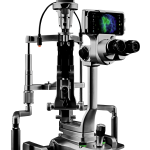 The new ION Slit lamp in her exam room has become a great patient education tool in just a few months. “I can take pictures, put them on my computer screen and share with the patients.” Dr. Sudarsky was recently recommending a switch to wear daily disposable contact lenses to a patient. “I was trying to convince her, and with the picture, I could show her that her current contact lenses were dirty, even when she said they were clean. A picture is worth a thousand words.”
The new ION Slit lamp in her exam room has become a great patient education tool in just a few months. “I can take pictures, put them on my computer screen and share with the patients.” Dr. Sudarsky was recently recommending a switch to wear daily disposable contact lenses to a patient. “I was trying to convince her, and with the picture, I could show her that her current contact lenses were dirty, even when she said they were clean. A picture is worth a thousand words.”
The OPD III has been a great asset for fitting contact lenses, and in particular, multifocal contact lenses. “It has a lot of great tools,” Dr. Sudarsky says. “I can tell if the patient’s visual axis is not the same as the center of the pupil, and I will know if multifocal contact lenses will work for them or not.” That can save her and the patient some frustration, especially compared to a system where she may have tried multiple lenses before reaching this conclusion.
Dr. Sudarsky says her efficiency has improved working with this technology, and she’s able to spend more time with each patient. “I have fewer remakes and better refractions,” she says. “I wonder how I practiced before it.”
Dr. Sudarsky didn’t know any colleagues who had technology from Marco when she took the leap, so she’s relied on the support of its team who have helped her with any question or issue that arises. She’s particularly thankful to her Marco support representative, who is a master at the OPD III and who helped Dr. Sudarsky understand how to utilize the many features and functions that the instrumentation has to offer. “They are just a text away and always willing to help,” she says.
The Marco iON Imaging System Intuitive, Optimized, and Networked
The TRS Refraction System – When You Need More Time
High-Tech Exam At A Personable But Appropriate Distance – An Article From Women in Optometry
Original Article Published in Women in Optometry
–
 When Patricia Haller, OD, added Marco technology to her Chillicothe, Ohio, practice in 2015, physical distancing was not even a thought. But when she closed her office to routine care for four weeks during the stay-home orders in the state, she realized how this same technology allowed her to see emergency and urgent cases and still maintain some distance. Dr. Haller’s practice reopened at a lighter schedule to routine eye care in early May. She discovered that Marco was a “hidden gem” in the post-COVID era.
When Patricia Haller, OD, added Marco technology to her Chillicothe, Ohio, practice in 2015, physical distancing was not even a thought. But when she closed her office to routine care for four weeks during the stay-home orders in the state, she realized how this same technology allowed her to see emergency and urgent cases and still maintain some distance. Dr. Haller’s practice reopened at a lighter schedule to routine eye care in early May. She discovered that Marco was a “hidden gem” in the post-COVID era.
REFRACTIONS AT A DISTANCE
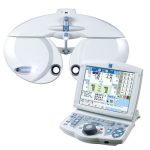 With the tabletop controller for her Marco 5100, she is able to conduct her refractions and sit about six feet away from the patients. “It’s also very easy to sterilize because all mechanisms are housed inside, so we wipe down the exterior casing without worrying,” she says.
With the tabletop controller for her Marco 5100, she is able to conduct her refractions and sit about six feet away from the patients. “It’s also very easy to sterilize because all mechanisms are housed inside, so we wipe down the exterior casing without worrying,” she says.
She already knew its value. “I purchased my first TRS in 2015 when I built the new office. I left a manual phoropter in one of my exam lanes,” she says. However, she quickly realized she didn’t want to use that room for patient exams. So now she has three units—one in each exam lane.
“It helps to keep the process streamlined. I can control the speed at which the refraction takes place,” she says—an even more important factor in the post-COVID opening. “We want patients moving through the office efficiently so that we do not have any backup in the reception area. With the TRS, it’s quick to arrive at a final refraction, and patients can see and justify their decision to buy new eyewear.”
READY TO BUY
That’s helpful because every practice is faced now with trying to make up time and lost revenue from being closed to routine care. Happily for her, she says that patients are returning, ready and eager to buy. “I was prepared for the fact that patients might not be ready to make purchases. The staff and I discussed ways in which we could help patients with their essential needs if their finances were tight,” she says. She’s not finding that to be a hindrance, however.
“They’re excited to be back and have been updating their prescription eyewear without any of the hesitation I thought that we’d see.” Dr. Haller says that it is helpful that patients can see the steps that she and the staff members are taking to keep the practice and optical clean and sanitized. “We have a UVC wand that we are using to sterilize every frame that a patient tries on before those frames are placed back on the boards. We used to wipe down our frames on a regular basis, but now they’re sterilized.”
The practice staff works on maintaining physical distancing, and opticians are masked. Patients who don’t wear a mask are offered one—and patients who would like to wait before coming in are rescheduled.
UNEXPECTED SURPRISE WITH iON
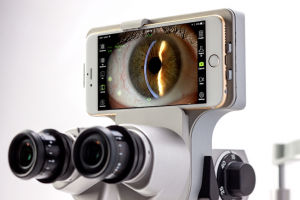
Dr. Haller added the iON imaging system to her slit lamps, allowing her to take an anterior segment image and immediately pull it up on the computer screen. She can pivot the screen toward the patient or toward an attending family member so that she can explain what she’s seeing.“I purchased the iON because I thought it would be terrific to do anterior segment documentation in the exam room where I could enhance details. The unexpected surprise is the physical distancing that I gain with this—while still providing patients with a comprehensive exam,” she says.
Dr. Haller uses Marco’s autolensmeter and autorefractor, appreciating how quickly information can be downloaded into the electronic health record. “Even before the patient is escorted to the optical, the opticians already know the lens designs and recommendations,” she says.
She knew the equipment she has been purchasing would bring her speed, accuracy and efficiency. “But the help it provides in this time is something no one could have foreseen,” she says. The combination of a high-tech, highly efficient exam process and the sanitization and safety protocols that are on display are raising the likelihood that patients are talking about the practice to their friends. “Patients are saying, ‘I had my exam there, and it’s safe to go in.’”
That feedback makes Dr. Haller happy. She says that she missed her patients. “Nothing replaces that feeling of seeing the smile on a patient’s face, knowing that you helped. It’s been challenging, as I’m a hand-shaker and hugger, but we’re managing. It’s great to see my patients back.”
[Webinar Recording] Want To Save Chair Time Fitting Lenses?
With Mayah Bowen, Director of Wavefront at Marco Ophthalmic
Topics Include:
– Wavefront Aberrometry
– Case studies
– OPD-Scan III
Request more information about Wavefront Aberrometry from Marco →
[Webinar Recording] How to Establish Safe Boundaries During a Comprehensive Exam
Brought to you by Advancing Eyecare.
Whether you’re a current Marco user or looking into the latest tools, Marco technologies can provide important patient safety measures in a post COVID-19 era.
A panel of doctors share their stories with digital refraction and slit lamp imaging that enable safe social distancing, minimize patient / doctor / staff exposure with flexible configurations, and facilitate remote exam capabilities with new software. Automated refraction offers the ability for a comprehensive, efficient, and safe exam. We also discuss software optimization to see more patients in less time, patient retention, and more.
View The Webinar ‘How to Establish Safe Boundaries During a Comprehensive Exam’:
View Marco’s Exclusive Offer →
How Eye Doctors Are Adapting To Provide Safer Eye Exams Beyond PPE and Sterilization
News Release Through PR Newswire
Technology Enables Eye Doctors to be in Another Room or Another Location
JACKSONVILLE, Fla., May 19, 2020 /PRNewswire/ — The country is carefully navigating through the COVID-19 challenge, and executive orders are being lifted in phases across the country. In the medical field, patients are able to selectively visit doctors for non-emergency procedures, including visiting their eyecare professionals. These medical professionals have countless resources available detailing safe guidelines through use of personal protective equipment (PPE), sterilization practices and protocols, check in and waiting room procedures, and more.
By nature, eye exams are up close and personal. Yet, how do you achieve acceptable safe social distancing for patients? The latest technology in eyecare now allows doctors to perform many tests from more than 6 feet away, from another room or even remote locations, and with even greater accuracy.
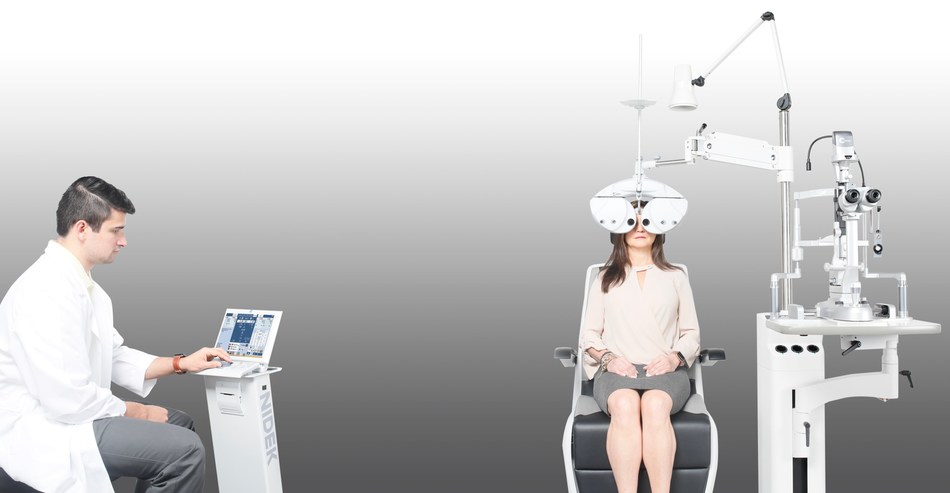
Marco Ophthalmic, a leader in vision diagnostics, has developed the latest refraction technology (used to determine new eyeglass/contact lens prescriptions) that is becoming the new normal in the post-COVID-19 world. Marco’s technology offers eyecare professionals flexibility to perform eye exams faster while maintaining social distance (they can use a control panel from over 6 feet away) and even offer full tele-medicine solutions by using web cameras to interact with patients. Marco technology also provides for greater efficiencies, helping to reduce time spent in the exam room and limit exposure for both the doctor and the patient without affecting the quality of the exam. In fact, Marco technology can even enhance the patient experience.
Historically, when a patient was asked the well-known question, “Which is better— 1 or 2?”, they were shown two different images, while the doctor flipped between lenses. Now with the new technology, the patient can view the images side-by-side. It is easier to give better answers to the doctor which, in turn, results in a more accurate prescription.
Dr. Coby Ramsey, who utilizes the technology at Ramsey Eye Care Center in Rock Springs, Wyoming said, “When COVID erupted we still wanted to be efficient and thorough, and we also wanted to be safe. Looking ahead, we will need to be even more aware of safe practices, and this is the new normal in eyecare. Social distancing doesn’t just mean staying 6 feet apart—it means doing everything we can to reduce exposure and keep our staff and patients healthy.”
Dr. Eric Hammond, who operates Lakeline Vision Source in Cedar Park, Texas, said, “A lot of people think you will lose the personal touch doing exams from a different room. But now more than ever I think patients are more appreciative and more comfortable. As we start to open back up to routine eye exams, I have found that patients are even more grateful of the extra protective steps we have taken from our sterilization practices to the technology we’ve invested in.”
Dr. Ramsey added: “We also plan to bring tele-optometry to our practice. The patients will continue to visit the office and will go through our advanced testing technology, while I can remotely analyze the results, prescribe what’s needed, and accommodate my patients’ busy schedules while providing the best care for their eye health. It’s a new world we’re living in, and we are adapting to best accommodate to protect our staff and patients.”
* Editor’s Note: Marco can help you locate eye doctors in your area if you are interested in reporting on this technology. Please email info@marco.com.
About Marco
Marco is the Leader in Vision Diagnostics®, committed to offering the finest in both classical and automated diagnostic instruments, for the complete practice. Products offered focus on high quality, ergonomically designed, integrated instruments that deliver efficiency. Superior educational tools, courses and extended protection programs accompany the products. Marco is headquartered in Jacksonville, FL. For more information, visit www.marco.com.
Related Information:
Marco Ophthalmic: https://marco.com/
COVID-19: A physician practice guide to reopening: https://www.ama-assn.org/delivering-care/public-health/covid-19-physician-practice-guide-reopening
American Academy of Ophthalmology: https://www.aao.org/
American Optometric Association: https://www.aoa.org/
[Webinar Recording] Cleaning and Disinfecting the Practice in the COVID-19 Era
Brought to you by Advancing Eyecare.
Reopening your practice for routine eye care involves numerous behind-the-scenes adaptations to ensure the safety and peace-of-mind of your patients, your staff, and yourself. With representation from industry-leading manufacturers, join us for an informational panel discussion to learn about cleaning, disinfection, and sterilization of your instruments and exam lanes. Every instrument has different requirements. This webinar covers what to look for in manufacturers’ instructions for use, red flags to be aware of to avoid damaging your instruments, different types of disinfecting agents, and more. Learn about sanitization of your exam lanes and instruments, myths and facts on the various types of tonometers, and what disposables and accessories are available to practice more safely.
Shop Disposables and COVID-19 Ready Accessories →
How We Create Future Successes – An Article From Optometric Management
By April Jasper, OD, FAAO
Chief Optometric Editor
OptometricManagement.com
Original Article Published in Optometric Management, May 2020
–
Experts tell us we are in unprecedented times and that the future is unpredictable. How are we to be courageous when that is the message we continue to hear? Let us slow down and look at some facts together:
- People continue to need eye care, glasses and contact lenses.
- Worldwide, myopia is a growing, major problem.
- More than ever, people are struggling with digital eye strain.
- Eye diseases are on the rise, and many are undetectable without a comprehensive eye health evaluation.
And the list goes on. . .
We can also predict that:
- The coronavirus will still be the virus and, at least for a little while, it will still create concern for our team and our patients.
- Patients may not have as much time off of work for visits during typical 9-to-5 hours.
- Patients who stocked up on contact lenses may not return for a while.
Now that we looked at the facts, let’s look for opportunities to be of value to our patients. Here, strategy is important. To help plan, I encourage you to read a book that was a tremendous resource to me following the financial crisis of 2007 to 2008. In the book Predictable Results in Unpredictable Times, authors Stephen Covey and Bob Whitman write, “If there is one thing that’s certain in business, it’s uncertainty. Still, there are great organizations that perform consistently and with excellence, regardless of the conditions.”
APPLYING THE LESSONS
Reading the book cover to cover, I applied as much as I could at the time. I then continued to adapt as ideas came to mind. The results, both financially and psychologically, were and continue to be, tremendous. Below are the general lessons the book teaches:
The Four Hazards of Unpredictable times are:
- Failure to execute your strategy. This can be either because your team doesn’t know the strategy or they were not trained to do what you asked. Good news here: We have time to make certain our teams are well trained and ready to execute.
- Crisis of trust either in the strategy, the leaders, the organization or the team. This crisis of trust can be in our patients, our employees or both. When they don’t trust the organization, everything slows down and revenues drop.
- Loss of focus on the strategy either due to the fact that your team is doing too many jobs at one time or because there is no leader who is monitoring progress with lead measures (those established to achieve the goals) and lag measures (those that determine whether you achieved your goals).
- Pervasive fear either of losing employment, being unable to get everything done at work and at home, getting sick, dying or not being able to pay the mortgage or other bills. This typically refers to employees, but can also apply to patients.
The reality is we must look at the facts, anticipate the hazards and then put a plan in place to avoid them. We can then create a strategy that executes the priorities with excellence, moves with the speed of trust, achieves more with less and reduces fear, not only in our team and our customers, but also in ourselves. As I worked through hazards 11 years ago, I was thrilled to see the results. We can do it again and, in doing so, we will create value for our patients and achieve success.
Email: april.jasper@pentavisionmedia.com
Twitter: @OptoManagement
Facebook: @OptometricManagement


